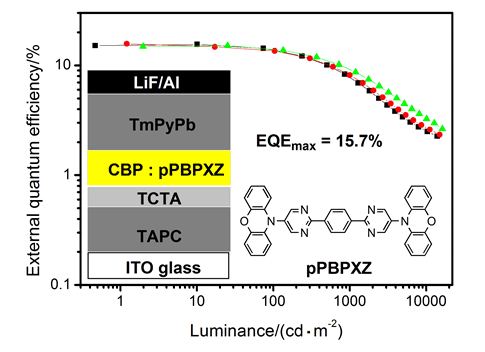| [1] Sun, Y. R.; Giebink, N. C.; Kanno, H.; Ma, B. W.; Thompson, M. E.; Forrest, S. R. Nature 2006, 440, 908.
[2] Reineke, S.; Lindner, F.; Schwartz, G.; Seidler, N.; Walzer, K.; Lussem, B.; Leo, K. Nature 2009, 459, 234.
[3] Helander, M. G.; Wang, Z. B.; Qiu, J.; Greiner, M. T.; Puzzo, D. P.; Liu, Z. W. Science 2011, 332, 944.
[4] Han, T.-H.; Lee, Y.; Choi, M.-R.; Woo, S.-H.; Hong, B. H.; Ahn, J.-H.; Lee, T.-W. Nat. Photonics 2012, 459, 105.
[5] Sasabe, H.; Kido, J. J. Mater. Chem. C 2013, 1, 1699.
[6] Zhang, Z.; Li, W.; Ye, K.; Zhang, H. Acta Chim. Sinica 2016, 74, 179(in Chinese). (张振宇, 李婉君, 叶开其, 张红雨, 化学学报, 2016, 74, 179.)
[7] Yu, Y.; Yang, J.; Ren, Z.; Xie, G.; Li, Q.; Li, Z. Acta Chim. Sinica 2016, 74, 865.
[8] Wang, F.; Cao, X.; Mei, L.; Zhang, X.; Hu, J.; Tao, Y. Chinese J. Chem. 2018, 36, 241.
[9] Liang, X.; Wang, Z.; Wang, L.; Hanif, M.; Hu, D.; Su, S.; Xie, Z.; Gao, Y.; Yang, B.; Ma, Y. Chinese J. Chem. 2017, 35, 1559.
[10] Lin, D.; Song, S.; Chen, Z.; Guo, P.; Chen, J.; Shi, H.; Mai, Y.; Song, H. Chinese J. Org. Chem. 2018, 38, 103(in Chinese). (林丹燕, 宋森川, 陈智勇, 郭鹏然, 陈江韩, 史华红, 麦裕良, 宋化灿, 有机化学, 2018, 38, 103.)
[11] Xu, H.; Chen, R.; Sun, Q.; Huang, W.; Liu, X. Chem. Soc. Rev. 2014, 43, 3259.
[12] Volz, D.; Wallesch, M.; Fléchon, C.; Danz, M.; Verma, A.; Navarro, J. M.; Zink, D. M.; Bräse, S.; Baumann, T. Green Chem. 2015, 17, 1988.
[13] Chi, Y.; Tong, B.; Chou, P.-T. Coord. Chem. Rev. 2014, 281, 1.
[14] Uoyama, H.; Goushi, K.; Shizu, K.; Nomura, H.; Adachi, C. Nature 2012, 492, 234.
[15] Tao, Y.; Yuan, K.; Chen, T.; Xu, P.; Li, H.; Chen, R.; Zheng, C.; Zhang, L.; Huang, W. Adv. Mater. 2014, 26, 7931.
[16] Kim, M.; Jeon, S. K.; Hwang, S. H.; Lee, S. S.; Yu, E.; Lee, J. Y. Chem. Commun. 2016, 52, 339.
[17] Lee, J.; Aizawa, N.; Yasuda, T. Chem. Mater. 2017, 29, 8012.
[18] Tamai, Y.; Ohkita, H.; Benten, H.; Ito, S.; Lee, J.-H.; Kido, J.; Park, J. J. Mater. Chem. C 2013, 1, 432.
[19] Chen, W.-C.; Lee, C.-S.; Tong, Q.-X. J. Mater. Chem. C 2015, 3, 10957.
[20] Chen, Y.-H.; Lin, C.-C.; Huang, M.-J.; Hung, K.; Wu, Y.-C.; Lin, W.-C.; Chen-Cheng, R.-W.; Lin, H.-W.; Cheng, C.-H. Chem. Sci. 2016, 7, 4044.
[21] Pan, Y.; Li, W.; Zhang, S.; Yao, L.; Gu, C.; Xu, H.; Yang, B.; Ma, Y. Adv. Opt. Mater. 2014, 2, 510.
[22] Konidena, R. K.; Thomas, K. R. J.; Dubey, D. K.; Sahoo, S.; Jou, J.-H. Chem. Commun. 2017, 53, 11802.
[23] Chen, W.-C.; Yuan, Y.; Ni, S.-F.; Tong, Q.-X.; Wong, F.-L.; Lee, C.-S. Chem. Sci. 2017, 8, 3599.
[24] Wang, Z.; Li, Y.; Cai, X.; Chen, D.; Xie, G.; Liu, K.; Wu, Y.; Lo, C.-C.; Lien, A.; Cao, Y.; Su, S.-J. ACS Appl. Mater. Interfaces 2016, 8, 8627.
[25] Chen, D.-Y.; Liu, W.; Zheng, C.-J.; Wang, K.; Li, F.; Tao, S.-L.; Ou, X.-M.; Zhang, X.-H. ACS Appl. Mater. Interfaces 2016, 8, 16791.
[26] Lee, D. R.; Choi, J. M.; Lee, C. W.; Lee, J. Y. ACS Appl. Mater. Interfaces 2016, 8, 23190.
[27] Cai, X.; Li, X.; Xie, G.; He, Z.; Gao, K.; Liu, K.; Chen, D.; Cao, Y.; Su, S.-J. Chem. Sci. 2016, 7, 4264.
[28] Li, F.; Xie, G.; Gong, S.; Wu, K.; Yang, C. Chem. Sci. 2016, 7, 5441.
[29] Rajamalli, P.; Senthilkumar, N.; Gandeepan, P.; Huang, P.-Y.; Huang, M.-J.; Yang, C.-Y.; Chiu, M.-J.; Chu, L.-K.; Lin, H.-W.; Cheng, C.-H. J. Am. Chem. Soc. 2016, 138, 628.
[30] Liu, X.; Zhan, C.; Zheng, C.; Liu, C.; Lee, C.; Li, F.; Ou, X.; Zhang, X. Adv. Mater. 2015, 27, 2378.
[31] Wang, K.; Zheng, C. J.; Liu, W.; Liang, K.; Shi, Y. Z.; Tao, S. L.; Lee, C. S.; Ou, X. M.; Zhang, X. H. Adv. Mater. 2017, 29, 1701476.
[32] Yang, Z.; Mao, Z.; Xie, Z.; Zhang, Y.; Liu, S.; Zhao, J.; Xu, J.; Chi, Z.; Aldred, M. P. Soc. Rev. 2017, 46, 915.
[33] Liu, Y.; Li, C.; Ren, Z.; Yan, S.; Bryce, M. R. Nat. Rev. Mater. 2018, 3, 18020.
[34] Wong, M. Y.; Zysman-Colman, E. Adv. Mater. 2017, 29, 1605444.
[35] Xiang, Y.; Gong, S.; Zhao, Y.; Yin, X.; Luo, J.; Wu, K.; Lu, Z.; Yang, C. J. Mater. Chem. C 2016, 4, 9998.
[36] Xie, G.; Li, X.; Chen, D.; Wang, Z.; Cai, X.; Chen, D.; Li, Y.; Liu, K.; Cao, Y.; Su, S. J. Adv. Mater. 2016, 28, 181.
[37] Chen, J.-X.; Wang, K.; Zheng, C.-J.; Zhang, M.; Shi, Y.-Z.; Tao, S.-L.; Lin, H.; Liu, W.; Tao, W.-W.; Ou, X.-M.; Zhang, X.-H. Adv. Sci. 2018, 5, 1800436.
[38] Chen, X.; Yang, Z.; Xie, Z.; Zhao, J.; Yang, Z.; Aldred, M. P.; Chi, Z. Mater. Chem. Front. 2018, 2, 1017.
[39] Chen, Y.; Li, S.; Hu, T.; Wei, X.; Li, Z.; Liu, W.; Liu, J.; Wang, R.; Yi, Y.; Zhao, C.; Wang, Y.; Wang, P. J. Mater. Chem. C 2018, 6, 2951.
[40] Xiang, Y.; Zhu, Z.-L.; Xie, D.; Gong, S.; Wu, K.; Xie, G.; Lee, C.-S.; Yang, C. J. Mater. Chem. C 2018, 6, 7111.
[41] Huang, J.; Nie, H.; Zeng, J.; Zhuang, Z.; Gan, S.; Cai, Y.; Guo, J.; Su, S.-J. Angew. Chem. Int. Ed. 2017, 56, 12971.
[42] Li, J.; Ding, D. X.; Tao, Y. T.; Wei, Y. Y.; Chen, R. F.; Xie, L. H.; Haung, W.; Xu, H. Adv. Mater. 2016, 28, 3122.
[43] Pan, K.-C.; Li, S.-W.; Ho, Y.-Y.; Shiu, Y.-J.; Tsai, W.-L.; Jiao, M.; Lee, W.-K.; Wu, C.-C.; Chung, C.-L.; Chatterjee, T.; Li, Y.-S.; Wong, K.-T.; Hu, H.-C.; Chen, C.-C.; Lee, M.-T. Adv. Funct. Mater. 2016, 26, 7560. |
